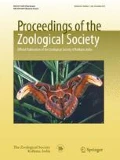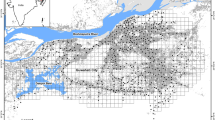Abstract
We studied the nest site characteristics features of House Sparrow Passer domesticus in highly crowded commercial zones of Guwahati city, Assam, India. Active nests of House Sparrow were recorded during the peak breeding season—February to April 2013. A total of 106 nests were recorded, out of which 36 % of nests were in colonies having more than two nests with a maximum of 20 nests in a single colony. The shutters were found to be the predominant substrates for nest construction. The average nest height was 3.78 ± 2.18 m. Most of the nests were recorded in less than 5 m height. The habitat patch selection for nesting might be a response to food availability or protection against abiotic factors. The availability or proximity of suitable foraging sites seems to be an important feature for nest site choice. The shopping centers with glass facades (exterior construction of the buildings) do not provide much space for placing the nests. The development of modern buildings is going to be a major threat to the breeding sparrows in near future.


Similar content being viewed by others
References
Alam, W. 2011. GIS based assessment of noise pollution in Guwahati City of Assam, India. International Journal of Environmental Sciences 2: 743–751.
Ali, S., and S.D. Ripley. 1983. Handbook of the birds of India and Pakistan, compact ed. New Delhi: Oxford University Press.
Anderson, T.R. 2006. Biology of the ubiquitous House Sparrow. Oxford: Oxford University Press.
Balmori, A., and O. Hallberg. 2007. The urban decline of the House Sparrow (Passer domesticus): a possible link with electromagnetic radiation. Electromagnetic Biology and Medicine 26: 141–151.
Bower, S. 1999. Reproduction, habitat use and population structure of a flock of House Sparrow in Hamburg. Hamburger avifaunistische Beiträge 30: 97–123.
Borg, C., and S. Toft. 2000. Importance of insect prey quality for grey partridge chicks Perdixperdix: a self selection experiment. Journal of Applied Ecology 37: 557–563.
Braden, G.T. 1999. Does nest placement affect the fate or productivity of California Gnatcatcher nests? Auk 116: 984–993.
Burger, J. 1985. Habitat selection in temperate marsh-nesting birds. In Habitat selection in birds, ed. M.L. Cody, 253–281. San Diego: Academic Press.
Burger, J., and M. Gochfeld. 1985. Nest site selection by Laughing Gulls: comparison of tropical colonies (Culebra: Puerto Rico) with temperate colonies (New Jersey). Condor 87: 364–373.
Cink, C.L. 1976. The influence of early learning on nest site selection in the House Sparrow. Condor 78: 103–104.
Clark, R.G., and D. Shutler. 1999. Avian habitat selection: Pattern from process in nest-site use by ducks? Ecology 80: 272–287.
Crick, H.Q.P., R.A. Robinson, G.F. Appleton, N.A. Clark and A.D. Rickard. (Eds). 2002. Investigation into the causes of the decline of Starlings and House Sparrows in Great Britain. BTO Research Report No 290, pp 1–9. DEFRA, Bristol. http://www.bto.org/research/archive/res_report_290.htm.
Daniels, R.J.R. 2008. Can we save the sparrow? Current Science 95(11): 1527–1578.
Gregory, R.D., M.A. Eaton, D.G. Noble, J.A. Robinson, M. Parsons, H. Baker, G. Austin, G.M.Hilton. 2003. The state of the UK‘s birds 2002. http://www.rspb.org.uk/ourwork/science/sotukb/index.asp.
Holway, D.A. 1991. Nest-site selection and the importance of nest concealment in the black-throated blue warbler. Condor 93: 575–581.
Hutto, R. L., and J. S. Young. 1999. Habitat relationships of landbirds in the Northern Region, USDA Forest Service. General Technical Report. RMRS-GTR-32. USDA Forest Service, Rocky Mountain Research Station, Ogden, Utah.
Kelly, J.P. 1993. The effect of nest predation on habitat selection by Dusky Flycatchers in limber pine-juniper woodland. Condor 95: 83–93.
Kheera, N., A. Das, S. Srivastava, and S. Jain. 2009. Habitat-wise distribution of the House Sparrow (Passer domesticus) in Delhi, India. Urban Ecosystem 13: 147–153.
Long, J.L. 1981. Introduced birds of the world. London: David & Charles.
MacArthur, R.H., J.W. MacArthurand, and J. Preer. 1962. On bird species diversity II. Prediction of bird censuses from habitat measurements. American Naturalist 96: 167–174.
Martin, T.E. 1993. Evolutionary determinants of clutch size in cavity-nesting birds: nest predation or limited breeding opportunities? American Naturalist 142: 937–946.
Martin, T.E. 1998. Are microhabitat preferences of coexisting species under selection and adaptive? Ecology 79: 656–670.
Martin, T.E., and J.J. Roper. 1988. Nest predation and nest-site selection of a western population of the Hermit Thrush. Condor 90: 51–57.
McKinney, M.L. 2002. Urbanization, biodiversity and conservation. BioScience 52: 883–890.
Miller, S.G., R.L. Knight, and C.K. Miller. 1998. Influence of recreational trails on breeding bird communities. Ecological Application 8: 162–169.
Mulsow, R. 2005. Hamburg. In Birds in European cities, eds. J.G. Kelcey, and G. Rheinwald, 127–152. St. Katharinen: Ginster.
Mulsow, R. 2006. The birdlife of Hamburg. Hamburger Avifauna Beitrage Special Edition IOC Hamburg 2006: 45–76.
Munro, H.L., and R.C. Rounds. 1985. Selection of artificial nest sites by five sympatric passerines. Journal of Wildlife Management 49: 264–276.
Newton, I. 2004. The recent declines of farmland bird population in Britain: an appraisal of causal factors and conservation factors. Ibis 146: 579–600.
Peach, W.J., K. Vincent, J.A. Fowler, and P.V. Grice. 2008. Reproductive success of house sparrows along an urban gradient. Animal Conservation 11: 493–503. doi:10.1111/j.1469-1795.2008.00209.x.
Prowse, A. 2002. The urban decline of the house sparrow. British Birds 95: 143–146.
Rajashekar, S., and M.G. Venkatesha. 2008. Occurrence of house sparrow, Passer domesticus indicus in and around Bangalore. Current Science 94(4): 446–449.
Remacha, C., and J.A. Delgado. 2009. Spatial nest-box selection of cavity-nesting bird species in response to proximity to recreational infrastructures. Landscape & Urban Planning 93: 46–53.
Robinson, R.A., G.M. Siriwardena, and H.Q.P. Crick. 2005. Status and population trends of Starling Sturnus vulgaris in Great Britain. Bird Study 52: 252–260.
Shaw, L.M., D. Chamberlain, and M. Evans. 2008. The House Sparrow (Passer domesticus) in urban areas: reviewing a possible link between post-decline distribution and human socioeconomic status. Journal of Ornithology 149: 293–299.
Singha, H., P. Deb, B. Chakdar, J.K. Roy, and M.R. Choudhury. 2011. Nest site selection by Passerines with special reference to House Sparrow (Passer domesticus) and Spotted Munia (Lonchurapunctulata) in a newly developed semi Urban hamlet in South Assam, India. Assam University Journal of Science and Technology: Biological and Environmental Sciences 8(1): 74–83.
Summers-Smith, J.D. 1963. The House Sparrow. London: Collins.
Summers-Smith, J.D. 2003. The decline of the house sparrow: a review. British Birds 96: 439–536.
Veit, R.R., and M.A. Lewis. 1996. Dispersal, population growth and the Allee effect: dynamics of the house finch invasion of eastern North America. The American Naturalist 148: 225–274.
Vincent, K. 2005. Investigating the causes of the decline of the urban house sparrow Passer domesticus in Britain. Ph.D. thesis, De Montfort University, Leicester. www.katevincent.org.
Yasué, M., and P. Dearden. 2006. The potential impact of tourism development on habitat availability and productivity of Malaysian plovers. Charadriusperonii. Journal of Applied Ecology 43: 978–989.
Acknowledgments
We would like to thank Aaranyak-Rufford small grant for the support. We are thankful to Ranjit Urnag and Tridip Saikia (AARANYAK) for their kind help during the study. We also like to acknowledge Namita Brahma for kind help and various supports during the study. Thanks to Samrat Sengupta, Manabendra Roy Choudhury, Biswajit Chakdar, Biswajit Deori and Jaynta Kr. Roy (Assam university) for providing literature during preparation of manuscript.
Author information
Authors and Affiliations
Corresponding author
Rights and permissions
About this article
Cite this article
Nath, A., Singha, H., Deb, P. et al. Nesting in a Crowd: Response of House Sparrow Towards Proximity to Spatial Cues in Commercial Zones of Guwahati City. Proc Zool Soc 69, 249–254 (2016). https://doi.org/10.1007/s12595-015-0149-4
Received:
Accepted:
Published:
Issue Date:
DOI: https://doi.org/10.1007/s12595-015-0149-4



